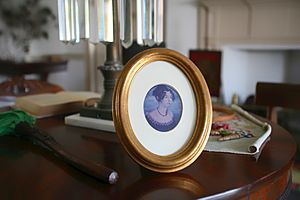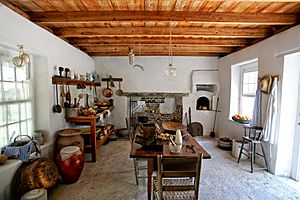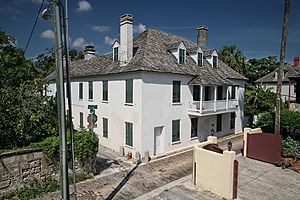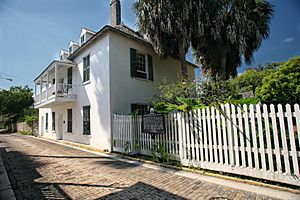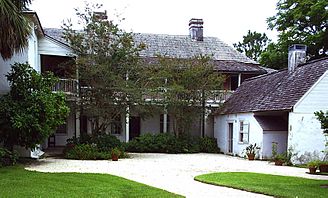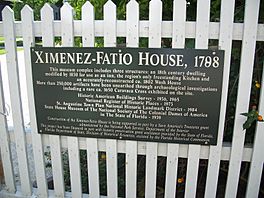Ximenez-Fatio House facts for kids
Quick facts for kids |
|
|
Ximenez-Fatio House
|
|
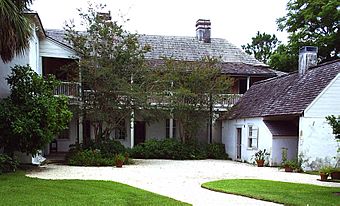 |
|
| Location | St. Augustine, Florida |
|---|---|
| Built | 1797-1802 |
| NRHP reference No. | 73002135 |
| Added to NRHP | July 25, 1973 |
The Ximenez-Fatio House Museum is a very old and well-kept building in St. Augustine, Florida. It shows what homes were like during Florida's Second Spanish Period (1783-1821). This period was when Spain controlled Florida for a second time.
The house became a National Register of Historic Places site in 1973. It was also named a Florida Heritage Landmark in 2012.
The museum is located on Aviles Street, which is one of the oldest streets in the United States. It sits in the heart of Old Town, the oldest part of St. Augustine.
Since 1939, a group called The National Society of The Colonial Dames of America in The State of Florida (NSCDA-FL) has owned and managed the property. They worked hard to restore the house. Now, it looks like a fancy boarding house from the early days of Florida tourism, which started after 1821.
The Ximenez-Fatio House is a historic house museum. It is set up to tell the stories of the people who stayed there. It also shares the lives of the women who owned and managed it. You can learn how people lived during Florida's time as a U.S. territory.
Contents
History of the Ximenez-Fatio House
The Ximenez-Fatio House has a long and interesting history. It was built by a Spanish merchant and later became a famous boarding house.
Andres Ximenez Builds the House
The main house, which has two stories, was built by Andres Ximenez. He was a merchant from Spain. He married Juana Pellicer, whose father was a leader in the Minorcan community of St. Augustine. The museum's name comes from Ximenez and Louisa Fatio, who was the last owner to run it as a boarding house.
Andres Ximenez built the house between 1797 and 1802. He designed it so his family could live upstairs. Downstairs, he ran a general store, a tavern, and even had a billiard table. His wife, Juana, likely helped him with these businesses. The Ximenez family did not live in the house for very long. By 1806, both parents had passed away. Juana's father then managed the property for their children.
Big changes came to St. Augustine after 1819. That year, Spain gave Florida to the United States in a deal called the Adams-Onis Treaty. St. Augustine became a popular place for visitors. People came to see the city or to escape cold northern winters. The Castillo de San Marcos, a Spanish fort, was now controlled by the U.S. military. This brought more soldiers to town. By 1821, Florida became a U.S. territory. More places were needed for visitors to stay. Many local people started renting out rooms and offering meals. This was known as a boarding house.
Margaret Cook's Boarding House
In 1830, Margaret Cook bought the Ximenez House. She had moved to St. Augustine in 1821. Margaret was a widow, which meant she could own property and run a business on her own. This was not common for women at that time.
Margaret Cook made changes to the house. She added more bedrooms to make it better for guests. She hired her friend Eliza Whitehurst, who was also a widow, to manage the boarding house. Under Eliza's care, "Mrs. Whitehurst's boarding house" became very well-known. Guests praised its high standards and delicious food. One visitor said, "...we were very fortunate in getting board at Mrs. Whitehurst's, considered the best in town." In 1835, 23 guests stayed at the house, mostly from the northeastern United States.
Sarah Petty Anderson Takes Over
In 1838, Eliza Whitehurst became ill and passed away. Margaret Cook then sold the boarding house to Sarah Petty Anderson for $4,000. Sarah and her husband were among many new people who moved to Florida in the 1820s. Sarah's family owned large plantations in Florida.
By the late 1830s, Sarah Petty Anderson was a widow living in St. Augustine. In the early 1840s, she hired Louisa Fatio to manage the Ximenez House as a boarding house.
Louisa Fatio's Famous Establishment
Louisa Fatio managed the house for Sarah Petty Anderson until 1855. That year, Louisa bought the house herself for $3,000. Louisa Fatio was well-educated for a woman of her time. Her family had a large plantation that was attacked during the Seminole Wars.
After moving to St. Augustine in 1836, Louisa found work managing boarding houses with her sister. She became known for her excellent food and comfortable rooms. Travelers often praised her hospitality. One writer, Charles Lanman, noted her reputation as a hostess. He said her establishment was "home-like and comfortable."
Under Louisa Fatio's management, the house on Aviles Street became known as "Miss Fatio's." It was a very popular place in St. Augustine until she passed away in 1875. The Fatio House even appeared in a fictional story by Constance Fenimore Woolson called "The Ancient City."
Around 1855, Louisa Fatio added a second floor of bedrooms to a part of the house. For many years, experts thought this addition was made earlier. But in 2009, scientists used a method called dendrochronology (tree-ring dating) to study the wood. They found that the wood was from the late 1850s, proving Louisa Fatio made the addition.
Louisa Fatio was also a main character in Eugenia Price's 1965 novel, Margaret's Story. This book is part of Price's "Florida Trilogy."
Architecture and Design
Records show that the main house and its separate kitchen were built in 1798. Both buildings are made from coquina rock. Coquina is a type of limestone made from shells, found on nearby Anastasia Island. Building with coquina meant the house was one of the fancier homes in St. Augustine during the Second Spanish Period.
The house is a great example of "St. Augustine Plan" architecture. This style mixes Spanish Colonial building ideas with more elegant Federal-style architecture. The Federal style was brought in during Florida's British Period (1763-1784). The house also has a separate coquina kitchen with a beehive oven. This is the only original 18th-century detached kitchen left in St. Augustine.
Why the Ximenez-Fatio House is Important
The Ximenez-Fatio House Museum is special for several reasons:
- Its unique architecture.
- How carefully it was restored to be very accurate. Experts used old records and archaeological finds to make it look just right.
- It teaches us about early Florida tourists and how they lived.
- It helps us understand the history of women in Florida in the 1800s.
The house has received several important recognitions:
- 1936 — Historic American Buildings Survey
- 1973 — National Register of Historic Places
- 1984 — St. Augustine Town Plan National Historic Landmark District
- 2012 — Florida Heritage Landmark
Florida's Territorial Period and Tourism
In 1822, Florida officially became the Florida Territory of the United States. With no international border, more Americans started traveling to Florida. Doctors even suggested Florida's mild winters for patients with illnesses like tuberculosis.
Even though travel was difficult, St. Augustine became a popular spot. Visitors often stayed for several months. They usually preferred boarding houses over public hotels. Boarding houses offered more personal attention and a higher standard of living. This time, after Florida became part of the U.S. in 1821, was the start of tourism in Florida. By 1834, St. Augustine had six boarding houses, and more opened later.
During this period, there were conflicts with the Seminole people. The Seminole Wars were fought over land and other issues. The Second Seminole War began in 1835. Some Seminoles chose to fight rather than move from their homes. Warriors led by Osceola attacked plantations. St. Augustine became a center for U.S. military actions. Soldiers often stayed in boarding houses. People from nearby plantations also sought safety in St. Augustine. Even with the conflict, visitors still came to the city, though numbers slowed down. St. Augustine was crowded with people needing places to stay. By 1845, when Florida became the 27th U.S. state, boarding houses were a big part of the city.
Archaeological Discoveries at the House
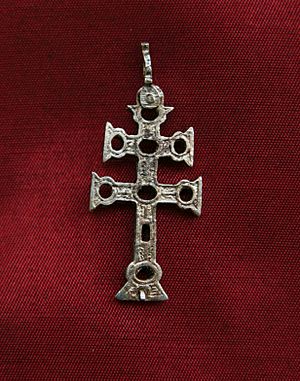
The Ximenez-Fatio House has been the site of more than 15 archaeological digs. This is more than any other property in St. Augustine! Archaeologists have found signs of people living on the property from the 1500s, 1600s, 1700s, and 1800s.
In 1976, a survey showed that the Ximenez-Fatio lot was near the center of the first Spanish settlement in the 1500s. Experts believe the site was always lived on by important people because of its high location and the artifacts found there.
Archaeological finds have helped confirm that the house was a boarding house in the 1800s. For example, animal bones in old trash pits showed what people ate. Pieces of china helped identify the dishes used by Sarah Petty Anderson. A collection of silver buttons and pins led to finding where a laundry shed once stood.
In 2003, archaeologists found a rare 17th-century double-barred, white bronze Caravaca cross. This cross was made in Spain and is two centuries older than the boarding house era. It is the most mysterious object found at the site so far.
A big archaeological dig took place at the front of the house in 2015. It was led by St. Augustine City Archaeologist Carl Halbirt.
Researching the House's History
After buying the Ximenez House in 1939, the Florida Dames group wanted to restore it accurately. They hired many top experts over the years. These experts included architects, archaeologists, and historians. One historian, William Seale, did a lot of research in the 1970s. His work helped the Colonial Dames understand how the house was used during Florida's territorial days.
Researchers used many old documents like maps, property records, letters, and wills. They also looked at city maps that showed how homes were built in St. Augustine during Spanish and British times. The first Spanish owner of the property was Cristoval Contreras. Artifacts found from his time suggest he was a high-ranking person in St. Augustine society.
Records show four owners during St. Augustine's British Period. After the British left Florida in 1783, the Spanish Crown likely took back the property. It was sold at auction in 1791. A map from that time shows the ruins of a stone house on the site. The 1791 sale record said the property was "lot only" with a structure "in shambles."
Later, Don Andres Ximenez bought the property in 1797. He already owned a store across the street. His will from 1802 mentioned the house and its separate kitchen, which helps historians know when it was built. His 1806 will listed the house and its contents, including a "grocery store and a billiard table." From sales records, historians learned what a general store in St. Augustine sold back then. Items included tobacco, children's books, brooms, vases, and buttons.
Legal documents also help us imagine the house as it was first built. A report from 1806 listed details like 15 doors, 16 windows, and wood for floors and ceilings. It also described the kitchen building and other structures like a privy (outhouse) and fences. The main house that stands today matches this 1806 description very well.
The National Society of The Colonial Dames of America
The National Society of The Colonial Dames of America (NSCDA) was started in 1891. Its goal is to help people understand and respect America's beginnings. This national group and its local societies are active in many states.
Colonial Dames work to achieve their mission through patriotic programs, education, and historical projects. They are leaders in saving and restoring historic places. The NSCDA has been recognized for its work at 85 historic properties. The NSCDA-FL, the Florida group, owns and runs the Ximenez-Fatio House Museum in St. Augustine.
Gallery




